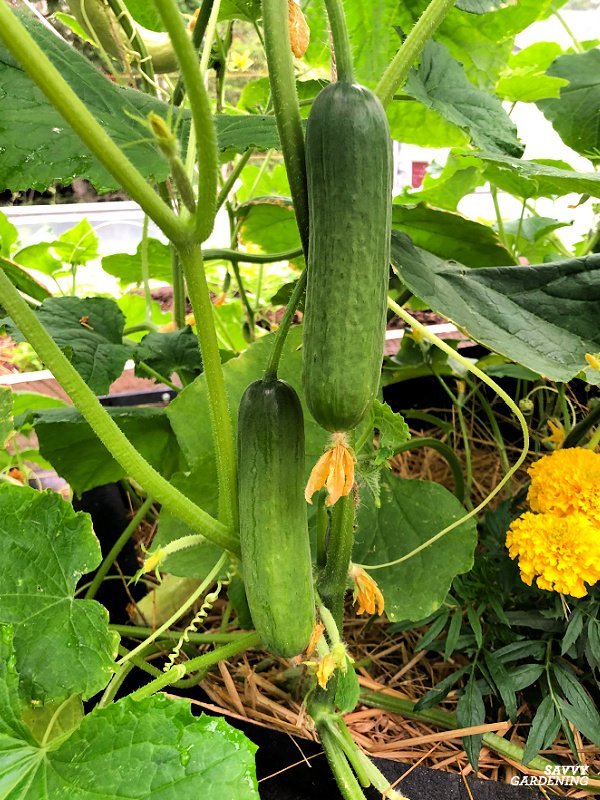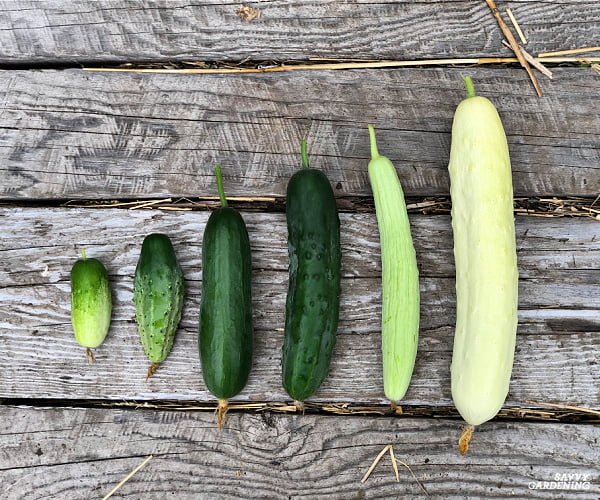If you’re an avid vegetable gardener or just trying your hand at growing Japanese cucumbers for the first time, you might be wondering when is the best time to pick these tasty and versatile vegetables. With their vibrant green color and crisp texture, Japanese cucumbers are a popular choice for salads, pickling, and even adding a refreshing crunch to sandwiches. But what is the ideal moment to harvest them for the best flavor and texture? In this article, we’ll explore the key factors to consider and help you determine the perfect time to pick your Japanese cucumbers.
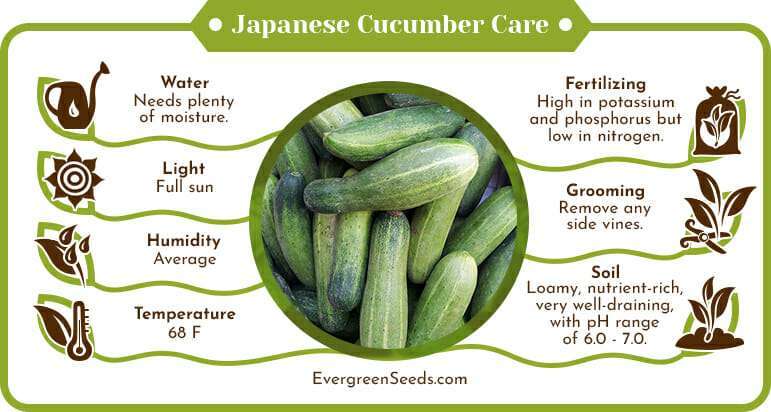
Factors to Consider
Variety of Japanese Cucumbers
When it comes to picking Japanese cucumbers, the first factor to consider is the variety. There are several different types of Japanese cucumbers, each with its own unique characteristics. Some common varieties include Kyuri, Suyo Long, and Hiyahiya. Each variety has distinct qualities in terms of size, color, texture, taste, and shelf life. Understanding the variety you are growing is crucial in determining the best time to pick your cucumbers.
Cucumber Size
The size of the cucumber is another important factor to consider when deciding the right time to pick. Japanese cucumbers are typically smaller than other types of cucumbers, ranging from 6 to 10 inches in length. However, the desired size may vary depending on personal preference and culinary needs. Generally, it is best to pick Japanese cucumbers when they have reached their optimal size for the specific variety.
Cucumber Color
Cucumber color can give valuable insights into their readiness for harvest. When it comes to Japanese cucumbers, the ideal color is usually a vibrant dark green. As the cucumbers mature, they develop a deep green hue, indicating their readiness to be picked. However, it is important to note that some varieties may have a lighter shade of green even when fully ripe. Therefore, it is crucial to refer to the specific variety’s color characteristics and rely on that as a guide for determining their ripeness.
Cucumber Texture
Texture is a significant factor to consider when choosing the perfect time to pick Japanese cucumbers. Ideally, these cucumbers should have a firm and crisp texture. When touched, they should feel dense and not give in easily. Soft or mushy cucumbers are typically overripe and may not have the desired taste or texture. It is important to monitor the texture of the cucumber to ensure it meets your preferences and culinary needs.
Cucumber Taste
Taste is one of the most important considerations when deciding when to pick Japanese cucumbers. These cucumbers are known for their refreshing and slightly sweet flavor. It is recommended to taste a sample cucumber from the vine to determine if it has reached the desired level of sweetness and flavor intensity. The taste will vary depending on the variety and the maturation stage, so it is crucial to monitor and taste test regularly to ensure optimal flavor.
Cucumber Shelf Life
Another crucial factor to consider when picking Japanese cucumbers is their shelf life. Japanese cucumbers are known for their excellent keeping qualities. They have a longer shelf life compared to other cucumbers, which makes them ideal for storing and using over an extended period. However, the shelf life can still vary based on the specific variety, freshness at the time of harvest, and proper storage methods. It is important to understand the expected shelf life of your chosen variety to ensure you can utilize your cucumbers effectively without waste.
Best Time to Pick Japanese Cucumbers Based on Factors
1. Variety of Japanese Cucumbers
To determine the best time to pick Japanese cucumbers based on variety, refer to the specific characteristics and recommendations for that particular type. Different varieties have different optimum harvesting times, and it is essential to understand these variations. Some cucumbers are best picked when small and tender, while others may develop a deeper flavor if allowed to grow larger. Research and consult resources specific to your chosen variety to ensure you harvest at the optimal time.
2. Cucumber Size
When considering the size of Japanese cucumbers, it is important to strike a balance between the desired culinary purpose and the natural development of the cucumbers. If you prefer smaller cucumbers, consider picking them when they reach 6 to 8 inches in length. These cucumbers are younger and tend to have a milder flavor. Larger cucumbers, around 8 to 10 inches, often have a more robust taste. Determine your preferred size and monitor the growth of your cucumbers to pick them at the ideal size for your culinary needs.
3. Cucumber Color
Color provides a visual clue to the ripeness of Japanese cucumbers. As mentioned earlier, a vibrant dark green color is generally an indication of ripe cucumbers. However, it is important to refer to the specific variety’s color guidelines, as some varieties may have different color characteristics when fully ripe. Regularly check the color of your cucumbers and harvest them when they exhibit the appropriate hue for their variety.
4. Cucumber Texture
Texture plays a vital role in determining the perfect time to pick Japanese cucumbers. Firm and crisp cucumbers are generally preferred, as they have a satisfying crunch and textural appeal. Gently squeeze the cucumbers to assess their firmness. If they feel mushy or have a softer texture, they may be overripe. Harvest your cucumbers when they maintain their optimal firmness, ensuring a pleasant crunch in every bite.
5. Cucumber Taste
Taste is perhaps the most subjective factor when it comes to picking Japanese cucumbers. The desired flavor can vary from person to person, and it largely depends on personal preferences and culinary intentions. To determine the best time to pick your cucumbers based on taste, regularly sample cucumbers from the vine. This will allow you to assess their sweetness and flavor intensity. Once they reach the desired taste profile, harvest them promptly to enjoy the perfect flavor in your dishes.
6. Cucumber Shelf Life
Considering the shelf life of Japanese cucumbers is important if you plan to store them for an extended period. These cucumbers generally have a longer shelf life compared to other varieties, but it is still essential to ensure their freshness and durability. Pick your cucumbers before they become overripe or develop blemishes. Additionally, proper storage techniques, such as refrigeration or pickling, can help extend their shelf life and maximize their usability.
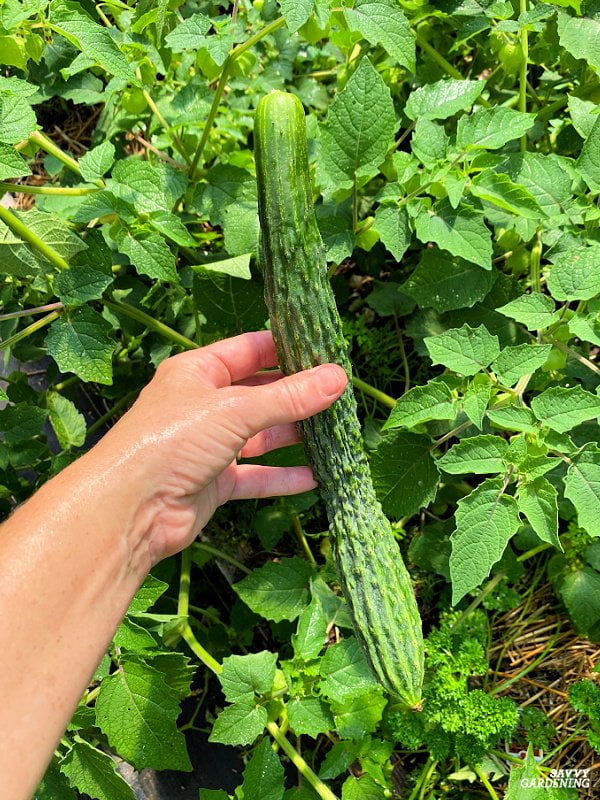
Signs of Ripeness
Cucumber Firmness
Firmness is a vital sign of ripeness when it comes to Japanese cucumbers. Ripe cucumbers should feel sturdy and not give in easily when gently squeezed. As cucumbers mature, they tend to lose their firmness, becoming softer and more pliable. Therefore, it is important to pick your cucumbers when they are still firm to ensure optimal taste and texture.
Smooth Skin
The skin of Japanese cucumbers should be smooth and free from any wrinkles or blemishes. Cucumbers with smooth skin indicate their freshness and ripeness. Avoid cucumbers with rough or spotty skin, as they may have been left on the vine for too long or subjected to unfavorable growing conditions. Smooth-skinned cucumbers are typically crisp and refreshing, making them ideal for various culinary uses.
Vibrant Color
Ripe Japanese cucumbers exhibit a vibrant dark green color that signifies their readiness for harvest. The color intensity may vary depending on the variety, but in general, a deep green hue is desirable. Avoid picking cucumbers that have a pale or yellowish color, as they are likely underripe and may lack the desired flavor and texture.
Crisp Sound
When harvesting Japanese cucumbers, listen for a crisp sound when snapping the cucumber off the vine. A ripe cucumber will produce a clean snapping sound, indicating its optimal ripeness. If the cucumber bends or doesn’t create a satisfying snap, it may not be fully ripe or may have begun to deteriorate. Pay attention to the sound and ensure you harvest your cucumbers when they produce a crisp snap.
Fresh Aroma
A ripe Japanese cucumber should have a fresh and pleasant aroma. Gently smell the stem end of the cucumber to assess its fragrance. A cucumber with a strong, fresh scent indicates its ripeness and flavor intensity. On the other hand, a musty or moldy smell may indicate spoilage or overripeness. Trust your sense of smell and pick cucumbers that have a delightful, crisp aroma.
The Influence of Environmental Factors
Temperature
Temperature plays a significant role in cucumber growth and ripening. Japanese cucumbers thrive in warm temperatures, with an optimal range of 70 to 90°F. Excessive heat can cause the cucumbers to ripen too quickly, resulting in a bitter taste and a compromised texture. In contrast, cooler temperatures can slow down the ripening process and delay harvest. Monitor the temperature in your growing environment and adjust accordingly to ensure optimal growth and ripening conditions for your cucumbers.
Sunlight
Sunlight is crucial for the growth and ripening of Japanese cucumbers. Cucumbers require at least 6 to 8 hours of direct sunlight daily to thrive. Sunlight helps facilitate photosynthesis, which provides the cucumbers with the energy they need to grow and develop their flavor. Insufficient sunlight can lead to stunted growth and underripe cucumbers. Ensure your cucumber plants receive ample sunlight to encourage healthy growth and optimal ripening.
Watering
Proper watering is essential for the optimal development and ripening of Japanese cucumbers. Cucumbers require regular watering to maintain consistent moisture levels in the soil. Overwatering can lead to waterlogged soil, which can negatively impact the overall health of the cucumber plants. On the other hand, underwatering can cause stress and hinder the ripening process. Strike a balance by watering your cucumber plants enough to keep the soil consistently moist but not saturated.
Humidity
Humidity levels can affect the growth and ripening of Japanese cucumbers. Cucumbers prefer moderate humidity, with levels ranging from 50% to 70%. High humidity can promote the development of diseases and pests, while low humidity can cause water stress and hinder nutrient absorption. Monitor the humidity levels in your growing environment and take appropriate measures to maintain an optimal range. Adequate airflow and proper ventilation can help control humidity levels and create a conducive environment for cucumber growth and ripening.

Best Practices for Harvesting Japanese Cucumbers
Inspecting the Plants Regularly
To ensure you pick your Japanese cucumbers at the peak of ripeness, it is essential to inspect your plants regularly. Check for any signs of changed color, size, or texture. Look for any blemishes or damage that may affect the quality of the cucumbers. Regular inspections allow you to identify cucumbers that are ready for harvest and ensure you don’t miss out on the optimal timing.
Using Pruning Shears or Scissors
When it’s time to harvest your Japanese cucumbers, it is best to use pruning shears or scissors instead of pulling or twisting the cucumbers off the vine. Pulling or twisting can cause damage to the plant and may result in uneven ripening or reduced productivity. Use clean and sharp pruning shears or scissors to make a clean cut near the stem of the cucumber. This will minimize any potential harm to the plant and ensure a smooth and healthy harvest.
Harvesting in the Morning
Harvesting your Japanese cucumbers in the early morning is generally recommended. During this time, the temperature is cooler, and the cucumbers are more likely to retain their crispness and firmness. Morning harvests also help minimize the risk of cucumber wilt or dehydration due to exposure to excessive heat. Aim to pick your cucumbers before the heat of the day sets in for optimal quality.
Avoiding Overripe Cucumbers
Overripe cucumbers can have a mushy texture, bitterness, or an unpleasant aftertaste. To avoid this, it is crucial to monitor your cucumber plants regularly and harvest the fruits promptly when they reach the desired ripeness. Leaving cucumbers on the vine for too long can lead to overripeness and compromises their quality. Harvest your cucumbers as soon as they meet your preferred ripeness criteria for the best taste and texture.
Gentle Handling
Handle your freshly harvested Japanese cucumbers with care to prevent any damage. Cucumbers are delicate and can bruise easily, which can affect their appearance and quality. Avoid dropping or throwing the cucumbers, as this can cause physical damage. Instead, gently place them in a basket or container to protect them during transport. Treating your cucumbers with care ensures they maintain their crispness and appearance until they reach your kitchen.
Storing Properly
Proper storage is crucial to maintain the freshness and quality of Japanese cucumbers after harvest. Ideally, store your cucumbers in a clean and dry refrigerator. Place them in a perforated plastic bag or wrap them in a paper towel to absorb excess moisture. Stored properly, Japanese cucumbers can stay fresh for up to a week, allowing you to enjoy them at your convenience. Avoid storing them near fruits such as apples or tomatoes, as ethylene gas released by these fruits can hasten cucumber spoilage.
Recipes and Culinary Uses
Japanese Cucumber Salad (Sunomono)
One popular culinary use for Japanese cucumbers is making a refreshing cucumber salad called Sunomono. This traditional Japanese dish is light, tangy, and perfect for summertime. Thinly slice the Japanese cucumbers and marinate them in a mixture of rice vinegar, sugar, and soy sauce. Add a touch of sesame oil, ginger, and garnish with sesame seeds or fresh herbs for an extra burst of flavor. Sunomono is a versatile dish that pairs well with various proteins, making it a delightful addition to any meal.
Cucumber Maki (Sushi Roll)
Another classic Japanese dish that showcases the versatility of Japanese cucumbers is Cucumber Maki, also known as sushi rolls. Cucumber Maki is a simple yet delicious sushi roll that highlights the crispness and mild sweetness of Japanese cucumbers. Combine thinly sliced cucumbers with sushi rice and your choice of fillings, such as avocado, crab, or tofu. Roll them in nori seaweed sheets and slice into bite-sized pieces. The combination of fresh cucumber and other complementary flavors creates a delightful sushi experience that is perfect for any sushi lover.
Tsukemono (Pickled Cucumbers)
In Japanese cuisine, pickled cucumbers, known as Tsukemono, are a popular accompaniment to meals. Tsukemono can range from tangy and crunchy to sweet and savory, depending on the pickling method and seasonings used. Japanese cucumbers are the perfect choice for making Tsukemono due to their ideal size and texture. The process involves brining the cucumbers in a mixture of salt, sugar, vinegar, and seasonings such as soy sauce, ginger, or chili pepper. The result is a flavorful and refreshing side dish that adds a burst of flavor to any meal.
Tempura Cucumber
Tempura is a popular Japanese dish that involves deep-frying various ingredients in a light and crispy batter. Tempura cucumbers are a unique and delicious way to enjoy Japanese cucumbers. To make tempura cucumbers, slice the cucumbers into thin strips and dip them in a tempura batter made from flour, water, and egg. Deep-fry the coated cucumbers until they turn golden brown and serve them with a dipping sauce such as tentsuyu. Tempura cucumbers are crispy on the outside, tender on the inside, and make a great appetizer or side dish.
Cucumber Smoothie
If you’re looking for a refreshing and healthy beverage, a cucumber smoothie is an excellent choice. Japanese cucumbers are a hydrating ingredient that adds a subtle sweetness and a cool, crisp taste to smoothies. Blend peeled and chopped Japanese cucumbers with Greek yogurt, fresh mint, a squeeze of lemon or lime juice, and a touch of honey or a natural sweetener of your choice. This combination creates a light and revitalizing smoothie that is perfect for hot summer days or as a post-workout drink.
Cucumber Gazpacho
Gazpacho is a chilled Spanish soup made primarily with fresh vegetables, including cucumbers. Japanese cucumbers are an ideal choice for making cucumber gazpacho due to their crisp texture and mild flavor. Blend peeled and seeded cucumbers with tomatoes, bell peppers, onions, garlic, olive oil, vinegar, and seasonings such as salt, pepper, and fresh herbs. Chill the gazpacho in the refrigerator to allow the flavors to meld and serve it cold as a refreshing and nutritious appetizer or light meal.
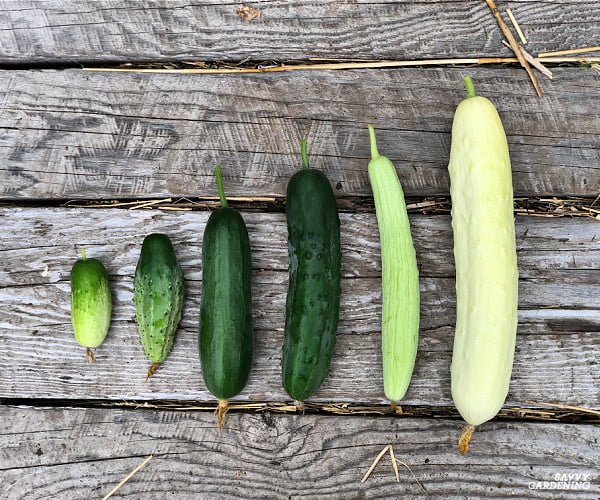
Bonus Tip: Continuous Harvesting
To ensure a steady supply of Japanese cucumbers throughout the growing season, practice continuous harvesting. Instead of waiting for all the cucumbers to ripen at once, pick them as they reach the desired size, color, and texture. Regularly inspect your cucumber plants and harvest cucumbers that are ready, leaving the younger ones to continue growing. Continuous harvesting not only ensures a consistent supply of fresh cucumbers but also encourages productive plants by preventing the development of overripe or spoiled cucumbers.
Conclusion
Picking Japanese cucumbers at the optimal time is crucial to ensure they have the desired flavor, texture, and quality. Factors such as the variety, size, color, texture, taste, and shelf life all play a role in determining when to harvest cucumbers. Additionally, environmental factors such as temperature, sunlight, watering, and humidity can influence their growth and ripening. By regularly inspecting the plants, using proper harvesting techniques, and considering culinary uses, you can enjoy the best-tasting Japanese cucumbers from your own garden. Whether you choose to enjoy them in salads, sushi rolls, pickles, or other dishes, the versatility of Japanese cucumbers makes them a delightful addition to any meal.
